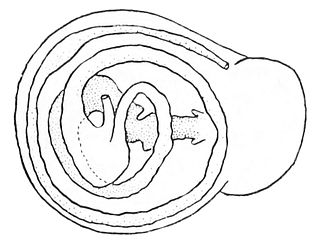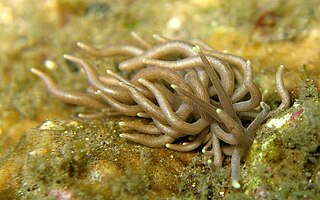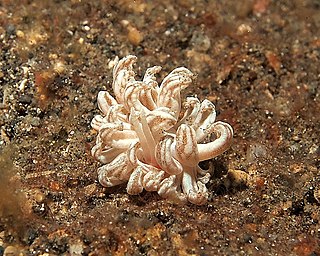
Onychophora, commonly known as velvet worms or more ambiguously as peripatus, is a phylum of elongate, soft-bodied, many-legged panarthropods. In appearance they have variously been compared to worms with legs, caterpillars, and slugs. They prey upon other invertebrates, which they catch by ejecting an adhesive slime. Approximately 200 species of velvet worms have been described, although the true number of species is likely greater. The two extant families of velvet worms are Peripatidae and Peripatopsidae. They show a peculiar distribution, with the peripatids being predominantly equatorial and tropical, while the peripatopsids are all found south of the equator. It is the only phylum within Animalia that is wholly endemic to terrestrial environments, at least among extant members. Velvet worms are generally considered close relatives of the Arthropoda and Tardigrada, with which they form the proposed taxon Panarthropoda. This makes them of palaeontological interest, as they can help reconstruct the ancestral arthropod. Only two fossil species are confidently assigned to as onychophorans: Antennipatus from the Late Carboniferous, and Cretoperipatus from the Late Cretaceous, the latter belonging to Peripatidae. In modern zoology, they are particularly renowned for their curious mating behaviours and the bearing of live young in some species.

The subphylum Chelicerata constitutes one of the major subdivisions of the phylum Arthropoda. Chelicerates include the sea spiders, horseshoe crabs, and arachnids, as well as a number of extinct lineages, such as the eurypterids and chasmataspidids.

Arachnida is a class of joint-legged arthropods, in the subphylum Chelicerata. Arachnida includes, among others, spiders, scorpions, ticks, mites, pseudoscorpions, harvestmen, camel spiders, whip spiders and vinegaroons.

The chelicerae are the mouthparts of the subphylum Chelicerata, an arthropod group that includes arachnids, horseshoe crabs, and sea spiders. Commonly referred to as "jaws", chelicerae may be shaped as either articulated fangs, or as a type of pincers. Some chelicerae, such as those found on nearly all spiders, are hollow and contain venom glands, used to inject venom into prey or a perceived threat. Both pseudoscorpions and harvestmen have additional structures on their chelicerae that are used for grooming.

Autotomy or 'self-amputation', is the behaviour whereby an animal sheds or discards one or more of its own appendages, usually as a self-defense mechanism to elude a predator's grasp or to distract the predator and thereby allow escape. Some animals have the ability to regenerate the lost body part later. Autotomy has multiple evolutionary origins and is thought to have evolved at least nine times independently in animals. The term was coined in 1883 by Leon Fredericq.

The woodlouse spider is a species of spider that preys primarily upon woodlice. Other common names refer to variations on the common name of its prey, including woodlouse hunter, sowbug hunter, sowbug killer, pillbug hunter and slater spider.

Kiwa is a genus of marine decapods living at deep-sea hydrothermal vents and cold seeps. The animals are commonly referred to as "yeti lobsters" or "yeti crabs”, after the legendary yeti, because of their "hairy" or bristly appearance. The genus is placed in its own family, Kiwaidae, in the superfamily Chirostyloidea.

Terrestrial animals are animals that live predominantly or entirely on land, as compared with aquatic animals, which live predominantly or entirely in the water, and amphibians, which rely on aquatic and terrestrial habitats. Some groups of insects are terrestrial, such as ants, butterflies, earwigs, cockroaches, grasshoppers and many others, while other groups are partially aquatic, such as mosquitoes and dragonflies, which pass their larval stages in water.

The anatomy of spiders includes many characteristics shared with other arachnids. These characteristics include bodies divided into two tagmata, eight jointed legs, no wings or antennae, the presence of chelicerae and pedipalps, simple eyes, and an exoskeleton, which is periodically shed.

Marine invertebrates are the invertebrates that live in marine habitats. Invertebrate is a blanket term that includes all animals apart from the vertebrate members of the chordate phylum. Invertebrates lack a vertebral column, and some have evolved a shell or a hard exoskeleton. As on land and in the air, marine invertebrates have a large variety of body plans, and have been categorised into over 30 phyla. They make up most of the macroscopic life in the oceans.

A woodlouse is any crustacean belonging to the suborder Oniscidea within the order Isopoda. They get their name from often being found in old wood, and from louse, a parasitic insect, although woodlice are neither parasitic nor insects.

The coconut crab is a terrestrial species of giant hermit crab, and is also known as the robber crab or palm thief. It is the largest terrestrial arthropod known, with a weight of up to 4.1 kg (9 lb). The distance from the tip of one leg to the tip of another can be as wide as 1 m. It is found on islands across the Indian and Pacific Oceans, as far east as the Gambier Islands, Pitcairn Islands and Caroline Island and as far south as Zanzibar. While its range broadly shadows the distribution of the coconut palm, the coconut crab has been extirpated from most areas with a significant human population such as mainland Australia and Madagascar.

The digestive system of gastropods has evolved to suit almost every kind of diet and feeding behavior. Gastropods as the largest taxonomic class of the mollusca are very diverse: the group includes carnivores, herbivores, scavengers, filter feeders, and even parasites.

Phyllodesmium is a genus of predatory sea slugs, aeolid nudibranchs, marine gastropod molluscs in the family Facelinidae.

Spiders are air-breathing arthropods that have eight limbs, chelicerae with fangs generally able to inject venom, and spinnerets that extrude silk. They are the largest order of arachnids and rank seventh in total species diversity among all orders of organisms. Spiders are found worldwide on every continent except for Antarctica, and have become established in nearly every land habitat. As of November 2023, 51,673 spider species in 136 families have been recorded by taxonomists. However, there has been debate among scientists about how families should be classified, with over 20 different classifications proposed since 1900.

Hemilepistus reaumuri is a species of woodlouse that lives in and around the deserts of North Africa and the Middle East, "the driest habitat conquered by any species of crustacean". It reaches a length of 22 mm (0.87 in) and a width of up to 12 mm (0.47 in), and has seven pairs of legs which hold its body unusually high off the ground. The species was described in the Description de l'Égypte after the French Campaign in Egypt and Syria of 1798–1801, but was first formally named by Henri Milne-Edwards in 1840 as Porcellio reaumuri. It reached its current scientific name in 1930 after the former subgenus Hemilepistus was raised to the rank of genus.
Phyllodesmium hyalinum is a species of sea slug, an aeolid nudibranch, a marine gastropod mollusc in the family Facelinidae.

Phyllodesmium jakobsenae is a species of sea slug, an aolid nudibranch, a marine gastropod mollusk in the family Facelinidae.

Gigantopelta chessoia is a species of deep sea snail from hydrothermal vents, a marine gastropod mollusk in the family Peltospiridae.

Crustaceans are invertebrate animals of the subphylum Crustacea, a large, diverse group of mainly aquatic arthropods including decapods, seed shrimp, branchiopods, fish lice, krill, remipedes, isopods, barnacles, copepods, opossum shrimps, amphipods and mantis shrimp. The crustacean group can be treated as a subphylum under the clade Mandibulata. It is now well accepted that the hexapods emerged deep in the Crustacean group, with the completed group referred to as Pancrustacea. The three classes Cephalocarida, Branchiopoda and Remipedia are more closely related to the hexapods than they are to any of the other crustaceans.



























